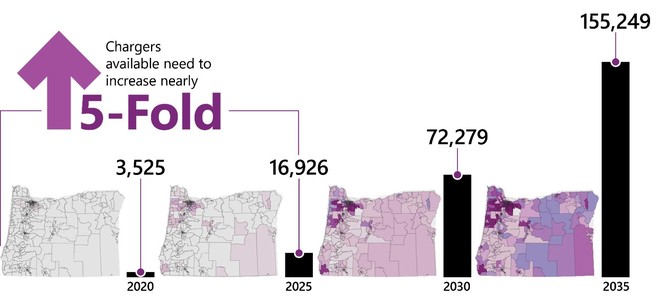Our report on charging infrastructure needs is live!
 Hello,
Last week we completed our final report on the Transportation Electrification Infrastructure Needs Analysis (TEINA), our study looking at Oregon’s zero emission vehicle charging needs over the next 15 years.
The study looked at light-duty electric cars, SUV’s, trucks and several other types of electric vehicles. It also examined different scenarios, and payed particular attention to rural and underserved communities.
We submitted our official report to Governor Kate Brown last week, and we wanted to share the results with you, too.
The full TEINA report is available online. You can also visit the TEINA webpage for additional study documents, archived public meeting materials and other resources.
Five key takeaways from the report
-
Our light-duty EV public charging needs are immediate. We need a 5x increase in the number of public charging ports by 2025, including workplaces, travel hubs, shopping plazas, and along highways. By 2035, we’ll need a 44x increase in charging ports.
-
Rural and urban communities need targeted investments. Both areas have “charging deserts” without easy-to-access charging options. They’ll need a combination of private and public investments to address urban equity gaps and rural distance challenges.
-
Public charging must be ubiquitous. Not everyone will have access to an at-home charging solution. Potential EV users need to feel confident that an EV will fit their lifestyle before they buy one.
-
Fleet vehicles need widespread charging support. Commercial delivery trucks, school and transit buses, long-haul trucking, light-duty fleets, etc. present a huge opportunity for electrification. But they face high barriers to get there.
-
Collaboration matters. ODOT is one player among many in the EV charging ecosystem. Partnerships among nonprofits, and public and private sectors — especially utilities — will be key.
What’s next?
Using what we’ve learned from the TEINA study, we’ll work with our partners to:
- Develop a “ZEV Charging Deployment Strategy” to prioritize EV charging investments over the next 2 - 5 years.
- Pursue more federal funding for EV charging infrastructure statewide.
- Undertake two planned studies: one on hydrogen refueling needs, and the other on barriers and opportunities for expanding use of e-scooters, e-bikes, and other micromobility options.
Thank you for your continued support for our efforts to address the effects of climate change in Oregon.
Sign up for more news about ZEV’s and charging infrastructure.
Send questions about TEINA or our other work to Climate.Office@odot.state.or.us.
Sincerely,
ODOT Climate Office
|